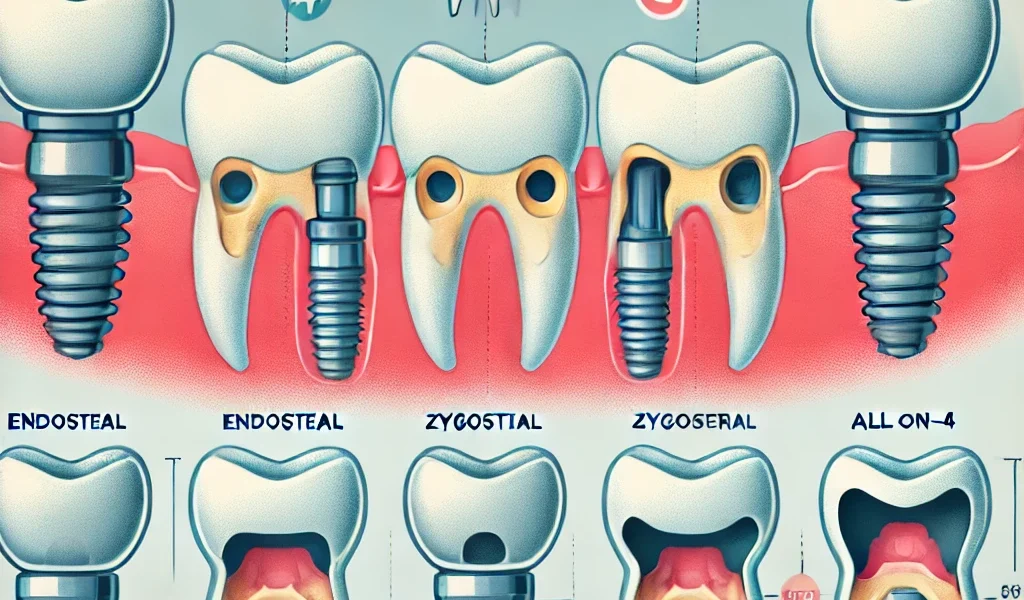4 Types of Dental Implants: Procedure, Costs, Pros, and Cons
Introduction
Dental implants have become an increasingly popular solution for individuals looking to replace missing teeth with a permanent, functional, and natural-looking option. Unlike dentures or bridges, dental implants offer a more durable and aesthetically pleasing result, making them a preferred choice for many patients. However, not all dental implants are the same, and it’s important to understand the different types available to find the best solution for your needs.
In this article, we will explore the four main types of dental implants, the procedures involved, the associated costs, and the pros and cons of each type.
1. Endosteal Implants
What Are Endosteal Implants?
Endosteal implants are the most common type of dental implant. These implants are typically made of titanium and are surgically placed directly into the jawbone. Once the implant integrates with the bone through a process called osseointegration, a crown is placed on top to mimic the appearance of a natural tooth.
Procedure
- Initial consultation: The dentist evaluates the patient’s jawbone structure and oral health.
- Surgical placement: The implant is surgically inserted into the jawbone.
- Healing period: Osseointegration occurs over several months, allowing the implant to fuse with the bone.
- Abutment and crown placement: Once healing is complete, an abutment (connector) is attached to the implant, followed by the placement of a dental crown.
Costs
Endosteal implants typically range between $3,000 and $5,000 per implant. Costs can vary based on geographical location, the dentist’s expertise, and the materials used for the implant and crown.
Pros
- High success rate: Endosteal implants have a very high success rate, with most lasting for many years.
- Natural appearance: The crown attached to the implant looks and functions like a real tooth.
- Durability: With proper care, endosteal implants can last a lifetime.
Cons
- Surgery required: The procedure involves invasive surgery, which may not be suitable for everyone.
- Healing time: It can take several months for the implant to integrate with the jawbone, requiring patience during the healing process.
- Adequate bone required: Patients need sufficient jawbone density for this type of implant to be successful.
2. Subperiosteal Implants
What Are Subperiosteal Implants?
Subperiosteal implants are placed under the gum but above the jawbone. This type of implant is typically used for patients who do not have enough healthy jawbone to support endosteal implants and are not candidates for bone grafting.
Procedure
- Initial consultation: The dentist examines the patient’s oral condition and determines if the subperiosteal approach is necessary.
- Custom framework creation: A custom framework is made to fit over the jawbone, beneath the gum tissue.
- Placement: The metal frame is placed under the gum tissue, with posts protruding through the gums. The artificial teeth are then attached to the posts.
Costs
Subperiosteal implants usually cost around $4,000 to $5,500 per implant. The cost can vary depending on the complexity of the case and the materials used.
Pros
- No bone graft required: Ideal for patients with insufficient jawbone density who don’t want or can’t undergo bone grafting.
- Less invasive: The surgery is less invasive than bone grafting and placing an endosteal implant.
- Shorter healing time: Healing is generally faster compared to endosteal implants since there’s no bone integration.
Cons
- Lower success rate: Subperiosteal implants have a lower success rate than endosteal implants.
- Less stability: Because the implant does not fuse with the jawbone, it may be less stable than endosteal options.
- Higher risk of complications: There’s a higher risk of the implant shifting or failing over time.
3. Zygomatic Implants
What Are Zygomatic Implants?
Zygomatic implants are less common and are used when a patient has severe jawbone loss in the upper jaw. Instead of being anchored in the jawbone, these implants are anchored in the zygomatic bone (cheekbone).
Procedure
- Initial consultation: The dentist assesses whether zygomatic implants are necessary, particularly if there is severe bone loss in the upper jaw.
- Implant placement: The implant is anchored in the zygomatic bone, bypassing the need for bone grafting.
- Abutment and crown placement: After healing, abutments and dental crowns are placed.
Costs
Zygomatic implants are more expensive, typically ranging from $5,000 to $7,500 per implant due to the complexity of the procedure and the specialized training required for the dentist.
Pros
- Ideal for severe bone loss: Provides a solution for patients with significant bone loss in the upper jaw without the need for bone grafting.
- Reduced treatment time: The procedure can be completed faster than a traditional implant with bone grafting.
- Long-lasting: These implants are durable and can last for many years.
Cons
- Complex procedure: The surgery is more complex than other types of implants and requires a highly skilled dental surgeon.
- Higher cost: Zygomatic implants are one of the most expensive implant options.
- Potential discomfort: Some patients may experience more discomfort post-surgery due to the location of the implant.
4. All-on-4 Implants
What Are All-on-4 Implants?
The All-on-4 dental implant system is designed for patients who are missing all or most of their teeth in a dental arch. Instead of placing individual implants for each tooth, the All-on-4 system uses four strategically placed implants to support an entire set of teeth, either on the upper or lower jaw.
Procedure
- Consultation and planning: A thorough evaluation is done to determine implant placement.
- Surgical placement: Four implants are placed into the jawbone, with two angled to increase stability.
- Prosthetic attachment: After the healing period, a full arch prosthesis (a set of artificial teeth) is attached to the implants.
Costs
All-on-4 implants generally cost between $15,000 and $30,000 per arch, depending on the materials used and the complexity of the case.
Pros
- Immediate results: Often referred to as “teeth in a day,” the All-on-4 system can provide a functional set of teeth in a single appointment.
- Fewer implants required: Only four implants are needed to support a full set of teeth, reducing the overall cost compared to individual implants for each tooth.
- Improved comfort: The implants provide a stable base for dentures, improving comfort and function.
Cons
- High cost: The procedure is significantly more expensive than single-tooth implants or other options.
- Complex maintenance: While durable, All-on-4 implants require meticulous oral hygiene and regular dental check-ups to ensure longevity.
- Bone density required: Patients still need sufficient bone density in the jaw to support the implants, although less is needed compared to traditional individual implants.
Conclusion
Dental implants are a valuable solution for replacing missing teeth, providing durability, functionality, and a natural appearance. However, the right type of implant depends on your individual oral health, bone structure, and budget. Whether you opt for endosteal, subperiosteal, zygomatic, or All-on-4 implants, each option comes with its own set of procedures, costs, and advantages. Consulting with a qualified dental professional is essential to determine which option best suits your needs and provides long-term success.




